I recommend practicing this at home to get to the point where you can start a fire in any condition and in short order. Pick a spot where you aren't likely to cause a fire to spread and ring it with rocks or bricks. Don't do this on a driveway as you can damage it with too much heat. You'll notice in the pictures below that I didn't ring the fire for ease of photographing only.
Prepare for the burn: Possibly the most crucial step is the one before you make the fire; gathering your materials. The rest is pretty easy if you get this down.
Fire building materials fall into a few basic areas:
Tinder - The stuff that starts to flame. Thinks small, thin stuff. Common tinders include cotton balls, wood shavings, thin bark and twigs, paper, artificial fire starters, dry pine needles, and leaves. I don't generally like leaves myself unless they are very dry. Below you'll see dryer lint in a toilet paper tube, and old Scouting favorite (if you mostly wear natural fabrics and don't stuff it too tightly)
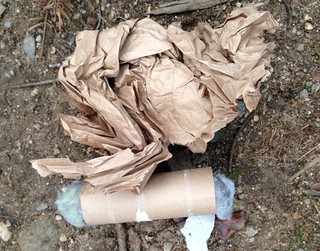 |
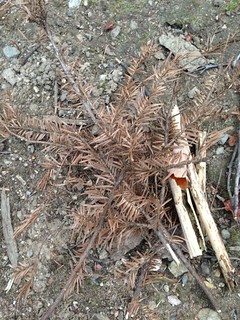 |
 |
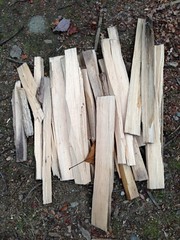 |
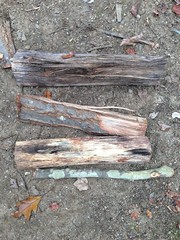 Putting it up: Take a few pieces of fuel size logs and build a windscreen. I like to stack 2 logs on top of each other to form a log cabin style. This leaves room for wind to come in and give air to the fire. Remember, a fire needs ignition, fuel, and oxygen, so don't choke it.
Putting it up: Take a few pieces of fuel size logs and build a windscreen. I like to stack 2 logs on top of each other to form a log cabin style. This leaves room for wind to come in and give air to the fire. Remember, a fire needs ignition, fuel, and oxygen, so don't choke it.
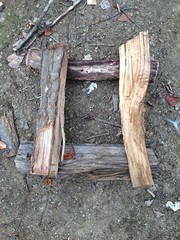 If you're dealing with a windy day, you may want to put all 4 logs flat on the ground. For the rest of these pictures, I've removed these pieces for photographic reasons. Usually they will be some of the first wood to catch.
Now you need to build the heart of the fire. The overall structure is pretty straight forward. It is that of a teepee rather than a random pile. Start by placing the smallest tinder in the center of where the fire will go, then begin placing the larder tinder and kindling on it with one end on the ground and the other ends coming together into a cone. Stack it in a manner that you leave space and air between sticks, though not too much room. Do make sure to leave a small opening in the bottom to of the construction to allow your fire to be started. Now you have to decide how to start it.
If you're dealing with a windy day, you may want to put all 4 logs flat on the ground. For the rest of these pictures, I've removed these pieces for photographic reasons. Usually they will be some of the first wood to catch.
Now you need to build the heart of the fire. The overall structure is pretty straight forward. It is that of a teepee rather than a random pile. Start by placing the smallest tinder in the center of where the fire will go, then begin placing the larder tinder and kindling on it with one end on the ground and the other ends coming together into a cone. Stack it in a manner that you leave space and air between sticks, though not too much room. Do make sure to leave a small opening in the bottom to of the construction to allow your fire to be started. Now you have to decide how to start it.
Traditionally
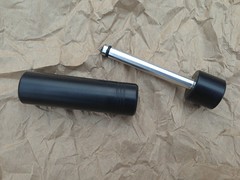 A fire piston
A fire piston
Or using a more modern method
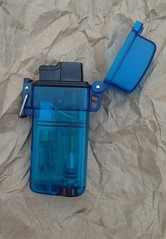 Weatherproof lighter
Weatherproof lighter
Light the tinder at the bottom of the fire:
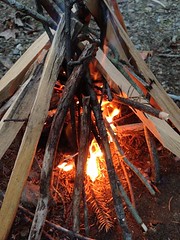
You might need to blow on the fire a bit to get it too spread, but don't do so until you have a bit of flame going. A little blowing to spread the flame around the tinder can be a good thing, but if you have to do it too hard or much, you may not have placed enough tinder or small kindling in the middle of the fire. With practice you end up with something that becomes this!
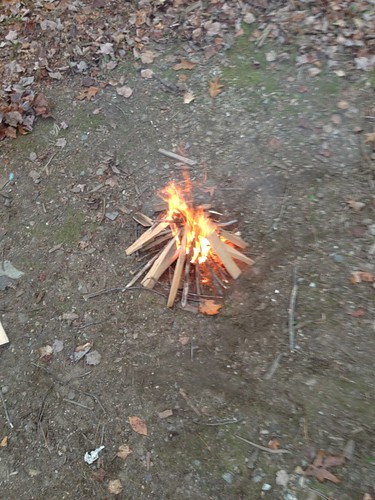
Now you have fire! This is the time to start putting on some fuel. Small at first, then add to it. The easiest way is to lay a few pieces across the top of your initial log cabin to catch. As you build up coals, you should have little problem keeping it going. Just remember to put i tout when you're all done, and I mean VERY out. With my model fire burning for under 5 minutes, I stomped it out...
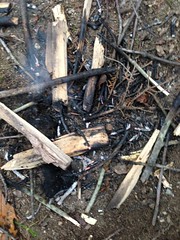 ...dropped a few leaves on the remains and blew.
...dropped a few leaves on the remains and blew.

So you can see how forest fires start! Please make sure you can touch the remains of your fire without feeling any heat. Now, do it all over again till you get it down tight. Good luck!
Hi Stephen! I didn't know you had a blog - I connected to you thru Bonnie, camp mom of Iron Hill Vagabonds. Surprising how similar lifestyles can parallel! Since moving north, Jordan and I have also gotten more on the "prepper" bandwagon, though we always were. I'm even writing a blog on a lot of it...I've linked to you there, I hope you don't mind.
ReplyDeleteGlad to get re-introduced!
Ann Weinstein
Hey Ann, glad you're abroad!
DeleteVery nice. The one thing I've learned is "don't build too much". In other words don't place all your tinder and probably none of your fuel at the outset. The fire is going to be dynamic and 9 times out of 10 where you placed the kindling is not exactly where the fire is burning the best.
ReplyDeleteReally? No swedish fire steel? I expect a more detailed post soon with more methods of starting... ;)
ReplyDeleteI can't overemphasize the idea that you need way more tinder than you think you do and you need way more kindling than you think you need. You almost always need less fuel than you think. This is especially important if kids are helping to gather materials. If you're in a real survival situation, this becomes way important.
when I tend to instruct on fires, I don't even mention leaves. Once they can start something without leaves (and @#$% on the pine needles, damn!) I'll tell them that sometimes leaves will work. Leaves rarely work well, I find.
Another tip, since you've likely got your knife, if you're really in a pinch, you can scrape your pants or jacket and come up with some nice ready made lint. Of course, you have to scrape properly so you don't cut yourself, but it was always a good trick to scrape up some lint in a fire building contest from nothing... heh. ;)
Dear unknown (? Who are you?) expect non-traditional techniques soon. You raise a great point on the pant lint idea, as long as you wear natural fibers. Nylon (like I sometimes where on wet days) sucks for starting lint. I agree on leaves (obviously), but truly dru needles are golem if you can find them. Hence encouraging folks to play at home. Thanks for the tips!
Delete